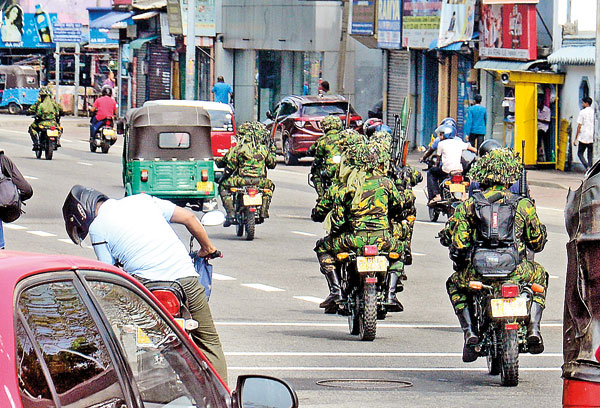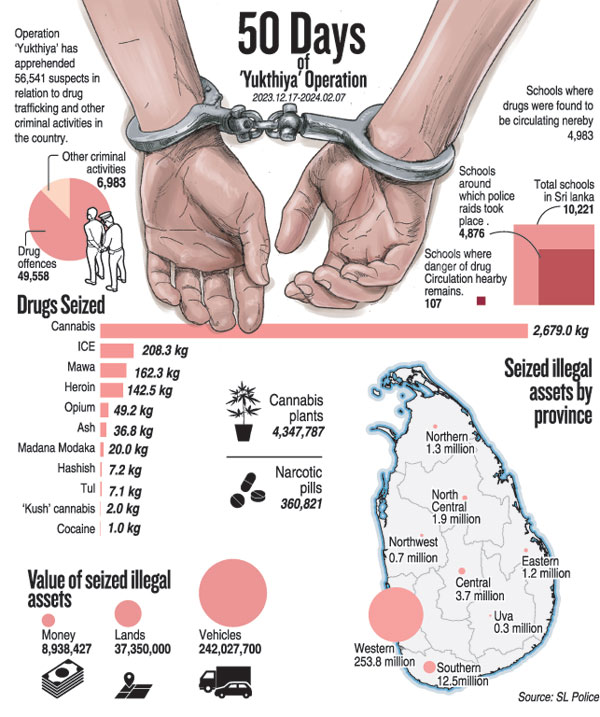News
Dealing a death blow to drug menace, say police
View(s):- As the controversy-ridden “Yukthiya” (Justice) operation reaches 50 days, Acting IGP Deshabandu Tennakoon talks about breakthroughs within and without the country
By Damith Wickramasekara and Sandun Jayawardana
Investigators have identified five key drug traffickers based in Europe, believed to be the masterminds behind large-scale narcotics smuggling into Sri Lanka, Acting Inspector General of Police (IGP) Deshabandu Tennakoon told the Sunday Times.
The suspects, all born in Sri Lanka, are now operating from a number of European countries, including France and Italy, the Acting IGP said. While most drug kingpins were earlier believed to operate from West Asian countries, he said police have reason to believe these five “key players” are responsible for much of the narcotics distribution in the country through their networks in West Asia and elsewhere.

Acting IGP Deshabandu Tennakoon
The traffickers use a variety of methods to smuggle narcotics via sea from West Asia and other regional countries. Main among these is the use of mid-sea transfers from foreign vessels to local multi-day fishing trawlers, which then transfer the cargo to smaller boats and dinghies when they get closer to shore. Mr. Tennakoon declined to name the alleged five Europe-based traffickers but claimed that an ongoing operation is on to track them down, have them arrested through Interpol, and have them extradited to Sri Lanka.
The traffickers were identified during an intelligence operation conducted as part of the ongoing island-wide “Yukthiya” (Justice) operation, according to Mr. Tennakoon. The intelligence operation commenced before Yukthiya, involving multiple agencies such as the Criminal Investigation Department (CID), the Police Narcotics Bureau (PNB), and the State Intelligence Service (SIS). He claimed the drug distribution networks run by the traffickers were so vast that drugs could reach all 14, 022 Grama Niladhari Divisions in the country. Investigators analysed data from both the PNB and SIS to try and trace the networks. “We identified 4200 agents who were in charge of distributing the drugs at Grama Niladhari Division levels. We have been focused since the start of the Yukthiya operation to disrupt and break up these distribution networks,” he said.
The Acting IGP acknowledged public criticism that police had not been able to effectively tackle the drug menace. “The first incident where heroin was detected in Sri Lanka occurred in 1982, when police arrested a local tourist guide in Katunayaka with heroin. Over the past 40 years, police have been carrying out anti-narcotics raids islandwide but have not been successful in eradicating the drug menace. On the contrary, the drug problem has actually increased over the past four decades. One main reason for this is that we were never able to conclusively identify who were the main traffickers that were smuggling drugs into the country on a large scale,” the Acting IGP said.
He said investigators had gathered enough information to identify the five key overseas-based traffickers currently responsible for large-scale drug trafficking into Sri Lanka.
While identifying these overseas-based drug traffickers was one thing, having them arrested in foreign jurisdictions and obtaining their extradition to Sri Lanka was a different matter. There have been occasions in the past where foreign courts have ruled against extraditing arrested suspects to Sri Lanka. Public Security Minister Tiran Alles, though, said the government would negotiate with its counterparts in countries where the traffickers are based with the aim of securing their arrests through Interpol and then work on having them extradited. He pointed out that last year, Sri Lanka was able to secure the extradition of alleged underworld figures Nadun Chinthaka Wickramaratne, alias “Harak Kata,” and his accomplice Salindu Malshika, alias “Kudu Salindu” from Madagascar. Therefore, it is not an impossible task, insisted the minister.
The seizure of both local and foreign fishing vessels containing heroin and other drugs has given rise to fears that Sri Lanka has also become a transshipment hub for drugs destined elsewhere. Police sources, though, claimed that the vast majority of the drugs seizedw recently were destined for Sri Lanka.
Weapons, including T56 assault rifles, pistols, and ammunition, have also been found, along with some drug consignments seized at sea. Many of the weapons are believed to be “gifts” that the drug traffickers send periodically to their local dealers. “Drug trafficking goes hand-in-hand with underworld activities. Traffickers are encouraging these underworld groups to continue with the drug trade. The weapons allow them to eliminate rivals and also carry out other crimes such as armed robberies,” said a senior police source.

On the trail of drugs: The Acting IGP insists that Yukthiya operation had widespread public support
A significant portion of the heroin smuggled into the country comes from the so-called “Golden Triangle” region in Southeast Asia, which comprises parts of Myanmar, Thailand, and Laos. Heroin is also smuggled to Sri Lanka from Afghanistan via sea routes from Pakistan and Iran. Narcotics-laden vessels follow the method of transferring their cargo mid-sea to local fishing boats to smuggle ashore. Authorities are on the lookout for narcotics-smuggling vessels from these regions and are trying to determine who is sending them. That is the start of the supply chain.
While cannabis and heroin continue to be the largest quantities of drugs that are being seized, research by institutions such as the National Dangerous Drugs Control Board (NDDCB) shows that there has been a significant increase in the possession and usage of crystal methamphetamine, also known as ‘Ice.’ Several multi-day fishing trawlers that have been seized by the Sri Lanka Navy in the seas off Sri Lanka in recent times were found to contain large stocks of methamphetamines in addition to heroin.
Police also say that the price of a packet of heroin has gone up by as much as 450% in some areas owing to the shortage of the drug due to raids and the arrest of street-level dealers since the start of the Yukthiya operation. Officers have observed that narcotic pills are being distributed as an alternative given the heroin shortage, said a senior officer involved in the operation. “We are finding more of these pills now in our raids. The pills also carry less severe penalties than heroin,” he added.
Acting IGP Tennakoon, meanwhile, dismissed allegations that police were only going after “small fry” and not “big fish” when it came to drug trafficking. “Those arrested during this operation include both high-level and low-level drug traffickers. Among the arrested are those who sold heroin packets weighing 20 milligrams, as well as others who were responsible for trafficking kilograms of the drug.”
He noted that law enforcement authorities were also using the Prevention of Money Laundering Act to take action against suspected drug traffickers. Various properties, including lands, luxury houses, hotels, apartments, and vehicles amounting to millions of rupees, have already been seized during the course of the Yukthiya operation. The assets are suspected of having been acquired illegally using money from drug trafficking. The suspected traffickers have purchased these assets under the names of their relatives and friends. The people under whose names the properties were purchased will now have to explain to authorities how they acquired the wealth to purchase the assets.
The traffickers live luxurious lives, the Acting IGP said. Many of their children are studying abroad. None of them are drug addicts. “Yet, their luxury lifestyles are fuelled by the misery of those who have become addicted to the drugs they sell.”

With the Yukthiya operation having now completed 50 days, Mr. Tennakoon is upbeat regarding its progress. He, however, conceded that when police take a drug dealer into custody, traffickers are able to quickly find “replacements” to take their place. “This is because this racket is a lucrative one. There are always those willing to take the risk of stepping into the shoes of another.”
On Friday (9), police announced that a list of 296 newly identified drug traffickers and 53 identified as associates of traffickers arrested under the operation had been given to all Senior Superintendents of Police (SSPs). The SSPs had been issued a separate list at the start of the Yukthiya operation, containing the names of 44,794 suspects wanted in connection with narcotics and non-narcotics-related crimes. Police said on Friday that 7494 of them have already been arrested.
At the start of the Yukthiya operation, Minister Alles said he hoped to make a “big difference” by June 30 this year and told the Sunday Times that this was being achieved. He insisted the operation had widespread public support. “Every time I go to a village, people come up to me and tell me that the operation has made a difference and appeal to me to continue with it,” he said.
| Focus on areas close to schools Authorities are also conducting anti-narcotics operations near schools after intelligence reports noted some drug dealers are actively targeting school students. Acting IGP Deshabandu Tennakoon claimed an intelligence report had identified that drug distribution was taking place close to the vicinity of nearly 5000 schools in the country. “This does not mean that drugs are being sold to school students in all these places, but we do know there are dealers who target school students. Police have already arrested about 500 suspects allegedly selling narcotics near schools and are looking to arrest about 200 more such suspects. There are about 107 schools located near shanties where drug dealing takes place, according to Mr. Tennakoon. He said the Special Task Force (STF) will be deployed to these places in the coming weeks to arrest sellers. “There is such drug selling near tuition classes as well. The CID and police intelligence services have been deployed to compile a list of persons selling in these locations and arrest them,” he added.
| |
| Community-based rehabilitation centres the way forwardNo anti-narcotics operation will succeed unless there is a concerted effort at demand reduction, and rehabilitating drug-addicted people is a key part of the Yukthiya operation, Acting IGP Tennakoon said.Police have been heavily criticised since the start of the Yukthiya operation for forcibly sending drug-addicted people for rehabilitation. The move to refer hundreds of such persons for mandatory rehabilitation has also resulted in overcrowding at existing centres. This has caused issues at places such as the Kandakadu Rehabilitation Centre, which has seen repeated clashes between inmates and mass breakouts in recent weeks.Mr. Tennakoon said police believe there are more than 100,000 drug-addicted people in the country. “If they aren’t successfully rehabilitated and convinced to stay off drugs, there will continue to be an attractive market for narcotics in the country. As long as the demand is there, someone will always step in no matter who we arrest.” Instead of sending drug-addicted persons for forcible rehabilitation, authorities are now attempting to begin a voluntary community-based rehabilitation project, set to begin next week with the assistance of the NDDCB, civil society organisations, and religious leaders. The plan is to open 250 new community-based rehabilitation centres around the country. Each centre will have room for 50 people, meaning 12,500 people can be rehabilitated at these centres at one time. This will be a marked improvement from the situation at present, where only 30 rehabilitation centres are in operation islandwide, with an annual capacity of 4700 persons. If the programme is successful, it will lead to a significant demand reduction, authorities noted. Research has shown that results from forcible rehabilitation in an institutional setting are low, with as much as 75% of those undergoing such rehabilitation relapsing into drug use after release, said Amaranath Tenna, Programme Director at the Alcohol and Drug Information Centre (ADIC). “Such persons are being forcibly rehabilitated in an artificial setting. In contrast, community-based rehabilitation in areas where drug-addicted persons reside and using such methods as peer-to-peer intervention have shown to have far better results.” He said there were also shortcomings in aftercare for rehabilitated inmates. They can become shunned by the community, which labels them as “kudu kaarayas.” As such, they need support from the authorities on how to live their lives in such a setting, said Mr. Tenna. “It should go beyond checking whether the person has relapsed and focus on helping them to live in such an environment. Such issues will be addressed in a community-based programme,” he said, adding that the new programme, if properly implemented, is the way forward. He said the current government-run rehabilitation centres can be improved too if significant changes are made. Firstly, the current period of one-year mandatory rehabilitation is too long and should be reduced. The centres should also be places where people would want to go voluntarily, rather than being sent against their will, he stressed. Mr. Tenna emphasised that prevention is the most important method when tackling drugs. “Since it is youths who are most at risk of becoming addicted to drugs, more drug preventive programmes at the school level should be implemented while existing legislation should be empowered, he said. “This is like falling into a waterfall. It’s always better to prevent people from falling in rather than try to rescue them at the bottom,” he observed. |
The best way to say that you found the home of your dreams is by finding it on Hitad.lk. We have listings for apartments for sale or rent in Sri Lanka, no matter what locale you're looking for! Whether you live in Colombo, Galle, Kandy, Matara, Jaffna and more - we've got them all!

